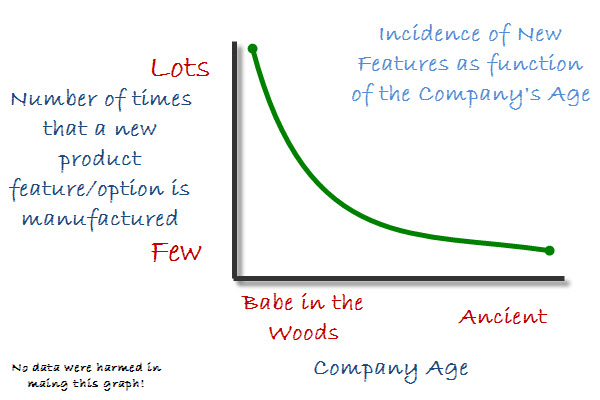
| 941.776.3830 | |
| Visibly Better! |
Everything That We do is Different

A number of years ago, I sat in the conference room of a laboratory equipment manufacturer and listened for perhaps the thousandth time in my career to someone say:
“Yes, everything that you have said is true, but your ideas won’t work here. You see, every order that we sell is different.”
Mind you, this was coming from the engineering manager of a company that published glossy catalogs and had cabinets of drawings that had been reused hundreds of times. They even had some parts that were repetitively manufactured and stocked. Yet it was the contention of this engineering manager that every order that came through the door required extensive review and new drawings from the engineering department.
On the other hand, you have different fingers.
--
Steven Wright
This man – whom we will call George – was not just protecting his turf. He truly believed everything that he said in that meeting. He was just wrong.
George’s attention and energy was completely consumed by the existing system. This caused him to lose sight of all of the machines that were unique the first time that they were done but had now become routine. To make up for the failure to define standard machines, he felt that he needed 100% inspection of orders to retain his peace of mind.

As a result, releasing any order to production required a detailed evaluation of the quote, purchase order, customer order and correspondence. Only then would Engineering proceed to redrawing some (or all) of the machine and developing a “release sheet.” This was a process that routinely took several months.
At that point a clerk made multiple copies of the drawings and assembled a thick drawing package. That, along with the release sheet, a Microsoft Excel bill-of-materials and the customer order were finally thrown over the wall to manufacturing and purchasing for action.
Someone would then hastily build the “job” in Visual Enterprise so purchasing and manufacturing could report costs. Not surprisingly the Visual form of the job was loaded with mistakes.
What is surprising is that most of the documentation released from Engineering was also loaded with mistakes!
Manufacturing and Materials Management was so accustomed to this situation that they routinely ignored this mass of documentation and re-engineered the job on the shop floor using the customer order as the primary source of information. In addition to wasting even more precious lead-time this reengineering introduced a whole slew of new purchasing and manufacturing errors which drove up costs and created unneeded inventory.
None of this re-engineering ever made it back to the engineering department. Even if it had, the information would have been considered useless since there was no central place where the errors could be corrected.
Most of the effort to ensure quality and order accuracy did nothing of the sort. Not surprisingly many engineering and production mistakes still made it to customers in the form of out-of-spec and non-working machines.
Because Visual Enterprise was used primarily in typewriter mode no one in manufacturing paid much attention to Visual or trusted the data that it contained. The only reasonably trustworthy source of data about the job was the paper file that eventually got stored in a mountain of Banker’s Boxes on the mezzanine.
I wish that I could say that I helped them resolve this problem overnight. Unfortunately the truth is more complex. For the most part, the issues at play were not technical in nature and were only tangentially related to Visual Enterprise. Mostly what I needed to do was work with them to change habits that may have been useful when the company was starting up, but which now become counterproductive and were inhibiting the company’s ability to continue grow and thrive.
During the next year I worked hard with the team members who understood what I was trying accomplish. I trained them to use Visual Enterprise as a tool to organize and standardize the definitions of some of their products and helped them act on that training.
I helped them develop a more systematic and efficient approach that could be easily applied to most of their orders. We did not tackle everything at once, but choose to work with the subset of products that most people grudgingly agreed were already pretty well defined in order to establish a process that dramatically sped up job releases and improved order accuracy.
Over time these successes wore down resistance in Engineering and other parts of the organization allowing us to establish beachheads in other product lines. Eventually we were able to introduce a model-based product philosophy throughout the company.
Our path to success was not a straight line. People actively and passively resisted the changes that I (and eventually others) advocated and there were times when our first approach to solving a problem didn’t work.
But in the end this company has substantially improved its delivery lead-time and its on-time-delivery statistics. It has also improved manufacturing quality (it is amazing what consistency will do for quality), eliminated shop-floor reengineering and established Visual Enterprise as a business-critical tool and sole source of truth.
George and the others who were the most convinced that everything that they did was different and that Visual Enterprise would not work, are now some of the loudest advocates for the new approach.
It might surprise you to learn that this company has not stopped making custom machines. However, they are a whole lot more efficient and quicker to deliver since many of their critical resources are no longer engaged in continuously replowing the same ground over and over again.
There is no doubt that custom product manufacturers have it tough. But by paying attention to efficient processes and recognizing that some of what they do is indeed repetitive, life can get a whole lot easier.
It would be my privilege to help you and your associates take a similar journey. I am Kurt B. Carr and I have years of experience in teaching companies how to use Visual Enterprise as a tool to operate effectively and achieve success. Call (941.776.3830) or email me today I believe that I can help you reignite your company’s growth and make your job fun and exciting again.
I can help...
- Consulting
- Training
Quotes on these pages are for illustrative and entertainment purposes only and are used under the fair-use doctorine of U.S. Copyright law. Absolutely no endorsement of Carr Enterprises services should be implied from use of the quote.
Contact Kurt Carr at: kurtcarr@carr-enterprises.com or: 941.776.3830